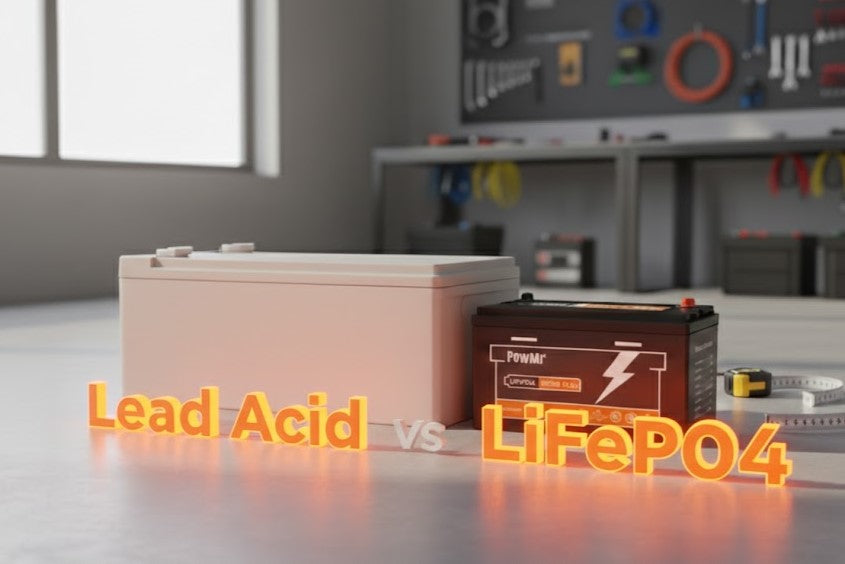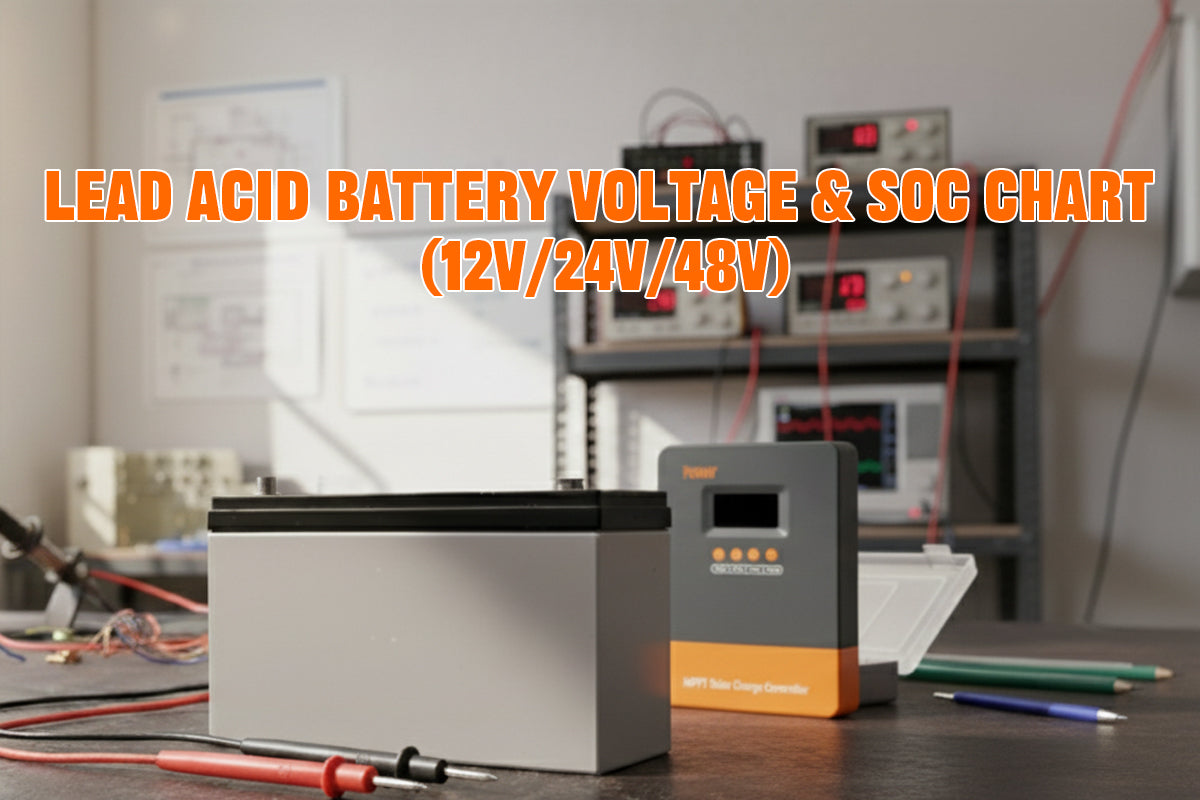"A LiFePO4 battery can cost 1.5 to even 3 times more than a lead-acid battery! That's expensive!" — this might have been your first thought when opening this article. And yes, at first glance, the price tag seems to make lead-acid batteries the clear winner.
But choosing the "cheaper" lead-acid option could end up being the most expensive decision for your energy storage in the long run. It sounds counterintuitive, doesn't it?
This guide goes beyond surface comparisons to deliver the technical and practical insight needed for confident decisions. We will break down key metrics such as charging, capacity, environmental tolerance, and total cost of ownership, so you can choose the ideal battery chemistry for your RV, boat, or off-grid solar system.
LiFePO4 vs Lead Acid Charging Methods
Charging process is one of the most significant operational differences between lithim iron phosphate (LiFePO4) and lead acid battery.
Charging curve of LiFePO4 battery
LiFePO4 batteries utilize a simple and efficient two-stage charging algorithm called Constant Current / Constant Voltage (CC/CV).
- Constant Current (CC): In the first stage, the charger supplies a steady current, quickly replenishing the bulk of the battery's capacity and the battery's voltage rises steadily.
- Constant Voltage (CV): Once the battery voltage reaches a preset limit, the charger holds the voltage constant. The battery's internal resistance increases as it fills, so the current it accepts will naturally taper off.
Related Articles:
Charging curve of lead acid battery
The charging of Lead-acid batteries (including Flooded, AGM, and Gel) typically involves three stages, with the first two stages resembling LiFePO₄ charging, and a third "float" stage required to maintain full charge.
- Bulk: Similar to the CC stage, the charger supplies maximum current until the battery voltage reaches a specific point. (Constant Current)
- Absorption: The charger then holds this absorption voltage constant while the current gradually decreases. This stage is crucial for fully saturating the lead plates but is notoriously inefficient and can take several hours. (Constant Voltage)
- Float: Once the absorption stage is complete, the voltage is lowered to a "float" level. This is a continuous, low-current charge designed to offset the battery's natural self-discharge rate and keep it topped off.
Related Articles:
Can I use a lead-acid charger on LiFePO4? (Why It's a Bad Idea)
Not recommended. Lead-acid chargers (including vehicle alternators and solar charge controllers) incorporate "Float" and "Equalization" phases, which can damage LiFePO4 batteries and shorten their lifespan.
The ideal solution is to replace it with a charger featuring dedicated "Lithium" or "LiFePO4" charging modes. If temporary use is unavoidable, ensure the charger's voltage remains within the acceptable range for LiFePO4 batteries and disable the equalization charging mode. Prolonged use of an incorrect charger will cause battery capacity degradation and damage.
Note: The PowMr charge controller allows selection between LiFePO4 and Lead-Acid modes, adjusting the charging curve to prevent overcharge and overvoltage, extending battery lifespan.
LiFePO4 vs Lead Acid Discharge Curve
Lead acid battery is characterized by a sharp drop in voltage once the depth of discharge (DOD) reaches around 50% of their capacity.

As illustrated in the discharge curves comparing lead-acid and LiFePO₄ batteries, the lead-acid curve has a steep, slippery slope, with voltage plunging rapidly at mid-discharge, whereas the LiFePO₄ curve features a long, flat plateau.
This behavior occurs because, during discharge, the sulfuric acid concentration in the lead acid electrolyte decreases, reducing the availability of hydrogen ions. At the same time, the internal resistance rises as the electrode plates become coated with PbSO₄, lowering reaction activity and causing the voltage to drop sharply.
The flatter the discharge curve, the more consistent the power your equipment receives throughout the entire discharge cycle. The differences between these two batteries affect not only power delivery over time but also the overall real-world user experience.
Lead Acid vs LiFePO4 - Detailed Comparison
Let's break down the core differences in a detailed, side-by-side technical analysis. This section will quantify the claims and provide the data you need to compare these two chemistries directly.
DoD and Lifecycle
As the depth of discharge increases, larger and more stable lead sulfate (PbSO₄) crystals form on the negative electrode of lead-acid batteries. These crystals are difficult to convert back into active material during charging and accumulate with each cycle. Therefore, lead-acid batteries are typically limited to 50% DoD to maintain a reasonable trade-off between energy utilization and durability.
Some deep-cycle lead-acid batteries, after structural reinforcement, can safely operate at 60–70% DoD. The table below summarizes typical DoD limits and corresponding cycle life for different types of lead-acid batteries:
| Battery Type | Recommended Max DoD | Typical Cycle Life |
|---|---|---|
| Flooded Lead-Acid | 50% | 300-500 cycles |
| AGM | 60 - 70% | 400-600 cycles |
| Gel | 50% | 500-800 cycles |
| LiFePO4 | 80-90% | 3000-5000+ cycles |
Capacity and Usability
So, for the purpose of extending battery lifespan, users should avoid discharging the battery beyond the manufacturer's recommended maximum depth of discharge. This means that even batteries with the same nominal capacity can deliver different amounts of usable energy depending on their chemistry.
For example, although both have a capacity of 100Ah, lead acid battery discharged to 50% DoD provides only 50 Ah of usable energy, whereas a 100Ah LiFePO₄ battery can safely supply up to 80Ah.
Charging Acceptance
How quickly a battery can be safely recharged is a critical factor and measured by the "C-rate," where 1C is a charge current equal to the battery's Ah rating.
Lead acid battery is typically limited to a charge rate of 0.1C to 0.2C (a 100Ah battery can only accept a 10-20A charge). The absorption phase is particularly slow and inefficient. Fully charging a lead-acid battery from 50% can take 6-10 hours.
LiFePO4 battery can accept charge at a very high rate, typically from 0.5C up to 1C (a 100Ah battery can be charged with 50A to 100A). This means you can recharge a LiFePO4 battery from empty to full in as little as 1-2 hours.
Battery Balancing
In a lead acid battery, with the cells built together into on sollid and unified structure, self-balances passively through electrolyte diffusion and internal resistance equalization. Once cells become imbalanced from sulfation or stratification, it's nearly impossible to restore uniform performance. Routine equalization charging (a controlled overcharge at low current) mitigates imbalance but increases water loss, heat, and plate corrosion.
LiFePO₄ batteries, by contrast, consist of multiple cells connected in series to achieve desired voltage, and each cell's voltage must be tightly controlled within a narrow range. To balance the cells within the pack, a Battery Management System (BMS) is integrated to continuously monitor, balance cells and provide protection against overcharge, over-discharge, short-circuit, and thermal runaway by automatically disconnecting the battery when limits are exceeded.
Power Density
Power density measures how much power a battery can deliver relative to its weight or volume, typically in watts per kilogram (W/kg).
Lead-acid batteries have relatively low power density, usually between 180–300 W/kg. High discharge currents cause significant voltage sag, heat buildup, and accelerated sulfation, which reduces both efficiency and cycle life. As a result, lead-acid batteries are better suited for steady, moderate-load applications rather than rapid bursts of power.
In contrast, LiFePO₄ batteries exhibit much higher power density, often in the range of 1,000–2,500 W/kg. Their low internal resistance allows them to maintain stable voltage under high-current loads with minimal heat generation. This makes them ideal for applications requiring rapid energy delivery, such as electric vehicles, high-power inverters, or peak-shaving in renewable systems.
Weight and Size
The difference of energy density directly affects both weight and physical footprint between lead acid and LiFePO4 battery.
For example, a 12 V, 100 Ah LiFePO₄ battery weighs just 11.5 kg and measures 330 × 171 × 215 mm, compared to a typical lead-acid battery weighing 28–37 kg with dimensions of 507 × 240 × 174 mm.
This represents a weight reduction of over 50–60% and a space saving of approximately 40–45%, making LiFePO₄ batteries significantly lighter and more compact for the same capacity.
Environmental Tolerance
How a battery performs at the extremes of temperature is a key operational constraint.
Cold Weather: This is the one area where lead-acid has a slight natural advantage in discharge. Its capacity is reduced in the cold, but it can still be discharged and charged (albeit slowly) well down to around -20°C to -30°C (-4°F to -22°F), depending on the type and electrolyte.
LiFePO4 batteries can discharge in cold temperatures (down to -20°C / -4°F) with only a moderate capacity reduction. However, their critical weakness is charging below 0°C (32°F). Attempting to charge a standard LiFePO4 battery below freezing can cause lithium plating, which is irreversible and permanently damages the cell.
Pro Tip: To solve this, many premium LiFePO4 batteries now come with internal heating systems. These systems use a small amount of charge current to warm the cells to a safe temperature before charging begins, making them a true four-season solution.
Hot Weather: LiFePO4 excels in the heat. While high temperatures accelerate degradation in all batteries, lead-acid life is drastically shortened. For every 10°C (18°F) increase above 25°C (77°F), a lead-acid battery's life is cut in half, so it has an upper operating temperature limit of around 50°C (122°F). LiFePO4 batteries maintain their performance and life much more effectively at elevated temperatures (up to 45-55°C / 113-131°F).
Safety and Maintenance
Lead-acid batteries are generally considered safe but come with some inherent risks and maintenance requirements, LiFePO₄ chemistry is inherently safer and more maintenance-friendly.
Lead Acid:
Lead-acid batteries are prone to sulfation and stratification internally, and generate gas during high-current charging. This gas release produces explosive hydrogen and oxygen, necessitating proper ventilation.
Overcharging flooded batteries causes electrolyte boiling and evaporation, necessitating regular level checks and distilled water replenishment, while keeping terminals clean to prevent corrosion and performing "equalization charging" to reverse sulfation. Although AGM and gel batteries are "maintenance-free" with built-in BMS for automated management, prolonged extreme discharging or improper charging can still cause sulfation or capacity loss.
LiFePO4:
LiFePO4 batteries feature exceptionally stable chemical properties, eliminating the need for electrolyte replenishment or equalization charging. They produce no hydrogen gas during normal operation and employ a sealed design, removing the ventilation concerns associated with lead-acid batteries. These battery packs are equipped with a BMS that prevents overcharging, over-discharging, overcurrent, and extreme temperatures, thereby enhancing safety and extending service life.
Charging Efficiency
Round-trip efficiency measures how much energy you get out of a battery compared to the amount you put in. The energy lost is primarily converted to heat.
Industry data shows lead-acid batteries have a round-trip efficiency of about 80-85%. For every 100 watts of solar power you generate to charge your battery, you will only be able to use 80-85 watts. The other 15-20 watts are wasted as heat during the charging process.
LiFePO4 batteries are exceptionally efficient, with a round-trip efficiency of 95-98%. That same 100 watts of solar power results in 95-98 usable watts. Over the life of the battery, this adds up to significant energy savings and allows you to size your solar array more effectively.
Lead Acid vs LiFePO4 Battery, Which is Right for You?
The choice between lead-acid and LiFePO4 isn't just about the initial price tag; it's about aligning the battery's capabilities with your specific needs, priorities, and long-term goals.
The "right" battery is the one that solves your problems without creating new ones. Do you need a simple, low-cost solution for infrequent use, or a high-performance, long-lasting power source that you can rely on day in and day out?
This next section will provide a clear decision-making framework to help you make that choice with confidence.
Lead Acid vs LiFePO4 Battery - Pros and Cons
To make the comparison as clear as possible, let's summarize the key differences we've discussed in a direct, side-by-side format.
| Feature | Lead Acid | LiFePO4 |
|---|---|---|
| Initial Cost | Low ($100-$300 for 100Ah) | High ($500-$800 for 100Ah) |
| Usable Capacity | 50% (50Ah from 100Ah) | 80-90% (80-90Ah from 100Ah) |
| Cycle Life | 300-800 cycles | 3000-5000+ cycles |
| Charge Time | 6-10 hours | 1-2 hours |
| Weight | Heavy | Light |
| Maintenance | Regular (water, cleaning, equalization) | None (zero maintenance) |
| Discharge Curve | Steep voltage drop | Flat, stable voltage |
| Temperature Performance | Poor in heat, OK in cold | Excellent in heat, needs heating for cold charging |
| Efficiency | 80-85% | 95-98% |
| Safety | Hydrogen gas risk, corrosive acid | Stable chemistry, BMS protection |
When Lead Acid is Better
There are specific scenarios where the proven, low-cost nature of lead-acid makes it the more sensible choice. You should stick with a lead-acid battery if:
- You have a strict upfront budget. If the initial purchase price is the most critical factor and you cannot accommodate the higher cost of LiFePO4, lead-acid is a functional and affordable way to get your system running.
- Your application is for standby or emergency backup. For a system that is rarely discharged, like a home sump pump or a UPS that spends 99% of its time on a float charge, the long cycle life of LiFePO4 provides no real benefit.
- Your usage is infrequent and very light. If you are a "weekend warrior" who uses your camper van or small boat only a few times a year for short trips with minimal power needs, the payback period for a lithium battery may be too long to be practical.
- You must charge in freezing temperatures without a heated battery. If your system absolutely must be able to accept a charge in sub-zero conditions and you do not have a LiFePO4 battery with a built-in heating function, a lead-acid battery's ability to charge (albeit slowly) in the cold is a key advantage.
When LiFePO4 is Better
The case for LiFePO4 is compelling and grows stronger every year. It is the superior choice if:
- You rely on your batteries daily. For off-grid living, full-time RVing, or marine cruising, the cycle life and performance of LiFePO4 are non-negotiable benefits. The answer to "is it worth upgrading rv to lithium battery" is a definitive yes for any serious RVer.
- Weight is a critical factor. In RVs, camper vans, boats, and portable applications, the 50-60% weight savings is a massive advantage.
- Fast charging is a priority. If you use solar or a generator, the ability to recharge in 1-3 hours (vs. 8-10 hours) fundamentally changes how you manage your energy.
- You need extended duration for demanding appliances. LiFePO4 excels at powering devices like microwaves, air conditioners, or trolling motors. Its stable voltage output under load prevents the premature inverter shutdowns common with lead-acid batteries, ensuring you can utilize the battery's full, deep-discharge capacity for significantly longer durations.
- You value a maintenance-free system. If you want to install your batteries and not worry about watering, cleaning terminals, or equalization charges, the zero-maintenance design of a LiFePO4 battery with an integrated BMS provides ultimate peace of mind and reliability.
Frequently Asked Questions (FAQ)
1. Can I mix LiFePO4 and lead-acid batteries?
Absolutely not. Their different voltage profiles, charge requirements, and internal resistances would cause them to fight each other, leading to dangerous charging conditions and damage to both batteries.
2. Are LiFePO4 batteries safe?
Yes. Lithium Iron Phosphate (LFP) is the safest and most thermally stable lithium-ion chemistry available. When paired with a quality BMS, they are significantly safer than traditional lead-acid batteries, which can vent explosive hydrogen gas.
3. Are LiFePO4 batteries useless in winter? I heard they can't charge at low temperatures.
Yes, but there are solutions:
- Purchase a BMS (Battery Management System) with built-in low-temperature cutoff protection. It will automatically prevent charging below freezing.
- Purchase LiFePO4 batteries with built-in heating functionality. They use the charging current to first heat themselves to a safe temperature before beginning the charge.
- Install the battery inside the vehicle or in an insulated box, away from the cold external environment.



